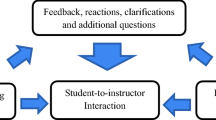Abstract
Online learning has minimized many barriers and constraints that are common in traditional learning environments. However, due to the absence of face-to-face contacts, students and instructors are usually faced with the lack of active social presence and meaningful interactions in online learning. This article explores a review of the literature on social presence and various types of interactions in online learning environments in the context of a class project. The findings suggest need for online instructors to explore effective ways to design and facilitate active social presence and meaningful interactions in online learning.
Similar content being viewed by others
References
Bing, W., & Ai-Ping, T. (2008). The influence of national culture toward learner’s interaction in the online learning environment: A comparative analysis of Shanghai TV University (China) and Wawasan Open University (Malaysia). The Quarterly Review of Distance Education, 9(3), 327–339.
Cameron, B. A., Morgan, K., & Williams, K. C. (2009). Group projects: Student perceptions of the relationship between social tasks and sense of community in online group work. The American Journal of Distance Education, 23, 20–33.
Ciges, A. S. (2001). Online learning: New educational environment in order to respect cultural diversity through cooperative strategies. Intercultural Education, 12(2), 135–174.
Davis, B. H., & Resta, V. K. (2002). Online collaboration: Supporting novice teachers as researchers. Journal of Technology and Teacher Education, 10(1), 101–117.
Dobbs, R. R., Waid, C. A., & Carmen, A. D. (2009). Students’ perceptions of online courses: The effect of online course experience. The Quarterly Review of Distance Education, 10(1), 9–26.
Huang, Y.-M., Jeng, Y.-L., & Huang, T.-C. (2009). An educational mobile blogging system for supporting collaborative learning. Educational Technology & Society, 12(2), 163–175.
Huang, J. J. S., Yang, S. J. H., Huang, Y.-M., & Hsiao, I. Y. T. (2010). Social learning networks: Build mobile learning networks based on collaborative services. Educational Technology & Society, 13(3), 78–92.
Janssen, J., Erkens, G., Kirschner, P. A., & Kanselaar, G. (2009). Influence of group member familiarity on online collaborative learning. Computers in Human Behavior, 25, 161–170.
Jonassen, D. H. (2000). Computers as mindtools for schools: Engaging critical thinking (2nd ed.). Upper Saddle River: Prentice-Hall Inc.
Kelly, D., Baxter, J.S., & Anderson, A. (2010). Engaging first-year students through online collaborative assessments. Journal of Computer Assisted Learning, 26(6), 535–548.
Kim, M. C. (2008). Using email to enable e3 (effective, efficient, and engaging) learning. Distance Education, 29(2), 187–198.
Leonard, J., & Guha, S. (2001). Education at the crossroads: Online teaching and students’ perspective on distance learning. Journal of Research on Technology in Education, 34(1), 52–57.
Lyons, A., Reysen, S., & Pierce, L. (2012). Video lecture format, student technological efficacy, and social presence in online courses. Computers in Human Behavior, 28(1), 181–186.
Makri, K., & Kynigos, C. (2007). The role of Blogs in studying the discourse and social practices of mathematics teachers. Educational Technology & Society, 10(1), 73–84.
Mayne, L. A., & Wu, Q. (2011). Creating and measuring social presence in online graduate nursing courses. Nursing Education Perspectives, 32(2), 110–114.
Overbaugh, R. C. (2002). Undergraduate education majors’ discourse on an electronic mailing list. Journal of Research on Technology in Education, 35(1), 117–138.
Petropouloua, O., Altanis, I., Retalis, S., Nicolaou, C. A., Kannas, C., Vasiliadou, M., & Pattis, I. (2010). Building a tool to help teachers analyze learners’ interactions in a networked learning environment. Educational Media International, 47(3), 231–246.
Puntambekar, S. (2006). Analyzing collaborative interactions: Divergence, shared understanding and construction of knowledge. Computer and Education, 47, 332–351.
Rhode, J. (2009). Interaction equivalency in self-paced online learning environments: An exploration of learner preferences. International Review of Research in Open and Distance Learning, 10(1), 1–23. Retrieved from ERIC database.
Salmoni, A. J., & Gonzalez, M. L. (2008). Online collaborative learning: Quantifying how people learn together online. Medical Teacher, 30, 710–716.
Simonson, M. (2000). Myths and distance education: What the research says (and does not). The Quarterly Review of Distance Education, 4(1), 277–279.
Thompson, L., & Ku, H. Y. (2006). A case study of online collaborative learning. The Quarterly Review of Distance Education, 7(4), 361–375.
Tu, C. H. (2005). From presentation to interaction: new goals for online learning technologies. Educational Media International, 42(3), 189–206.
Tu, C. H., & Corry, M. (2003). Building active online interaction via a collaborative learning community. Computer in the Schools, 20(3), 51–59.
Wang, Q., & Woo, H. L. (2007). Comparing asynchronous online discussions and face-to-face discussions in a classroom setting. British Journal of Educational Technology, 38(2), 272–286. doi:10.1111/j.1467-8535.2006.00621.x.
Woods, R. H. (2002). How much communication is enough in online courses? Exploring the relationship between frequency of instructor-initiated personal email and learners’ perceptions of and participation in online learning. International Journal of Instructional Media, 29(4), 377–394.
Yang, S. J. H., & Chen, I. Y. L. (2008). A social network-based system for supporting interactive collaboration in knowledge sharing over peer-to-peer network. International Journal of Human-Computer Studies, 66, 36–50.
Author information
Authors and Affiliations
Corresponding author
Rights and permissions
About this article
Cite this article
Keengwe, J., Adjei-Boateng, E. & Diteeyont, W. Facilitating active social presence and meaningful interactions in online learning. Educ Inf Technol 18, 597–607 (2013). https://doi.org/10.1007/s10639-012-9197-9
Published:
Issue Date:
DOI: https://doi.org/10.1007/s10639-012-9197-9




